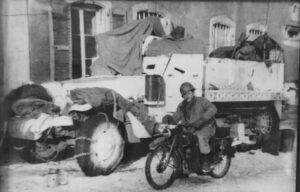
Charles Leo Kozol, born on June 16, 1910 as one of fifteen children, grew up in the southeastern side of Omaha, known at the time as Sheelytown, Stockyards dominated the area, including those owned by the Sheely family. During his youth, he loved to play softball, ice skate, hunt and fish.
Charles left school after the seventh grade to work for his father who owned a butcher shop, a construction company, and a coal delivery company. While working in the butcher shop, he learned Polish, German and some Czech and German as well. This made him popular among the old Polish ladies who requested that he make coal deliveries to their house because they did not know English.
During the 1920’s, Charlie would take fishing trips to Leach Lake in Minnesota. While there, he would also make short detours into Canada where he would purchase “amber liquid” and hide it under the running boards of his Model T. Returning to Omaha with his “catch” he would sell the alcohol out of his father’s butcher shop.
During the Depression, Charles would climb among the girders of the Bancroft Bridge in Omaha, searching for pigeons that he could take home for he and his family to eat.
At some point, he met his future wife, Bessie. During their courtship, he and his family built the house in which they hoped to raise a family in. Because of his experience in construction, the cost of the house was less than $4000, despite the fact that it was made of brick. Most of the wood used in the framing was recycled from other construction projects Charles had worked on.
However, before they could marry and move into the house, the United States entered the Second World War. Charlie volunteered for military service, and entered the army at the rank of private. He was assigned to the Third Army, 4th Armored Division, 51st Armored Infantry Battalion, Company B. For the duration of the war and one year after, the house he built for Bessie would be rented out while he was away. Eight days before shipping out to England, Bessie and Charles married on December 4, 1943 in Brownwood Texas near Camp Bowie. Bessie returned to Omaha, and lived in the house of Charles’s father.
In the service, Charles gained the nickname Pappy or Grandpa from his fellow enlisted men. In his early thirties by this time, he was one of the oldest men in his unit. Charles drove a vehicle known as a halftrack during the war because of his experience driving heavy coal trucks in Omaha. His halftrack was also the “command track” which included all the radio equipment for his unit, as well as the general in charge. His outfit landed at the Normandy beachhead, and later raced to the town Bastogne, Belgium following the famous German counter-offensive.
During his tour of duty, he won three medals, including the Combat Infantry Badge, a Bronze Star and a Purple Heart. Here is a quote from one of those citations:
“[He] performed his duties in a consistently superior manner. He took his vehicle over thousands of miles of extremely rough terrain, and through all types of weather, through artillery barrages and smoke screen, day and night. He kept his vehicle always in good running condition and always accomplished successfully all tasks assigned to him. His mechanical skill, loyalty and extreme devotion to duty reflect great credit upon himself and the Armed Forces of the United States.”
During his service, he was captured and held as a POW for a few days, but was able to escape. He also saved the life of an officer, who phoned him years later to thank him. The details of these events are lost, unfortunately. Charles was a quiet man, and did not speak of his war experiences often when he returned.
Charles had four brothers who also served during the Second World War. All five of the Kozol boys returned safely.
After the war, Charles and Bessie began their life together, but were not able to move into their house until after the lease ended with the renters who occupied it while he was away. Once settled, the couple had three children: Dennis born in 1947, Rita – my mother — in 1950 and Cathy in 1951.
After the war, Charles worked for his father for a time, and then worked for Ryan Construction. Never afraid of heights, Charles helped build towering grain silos. During the 1950’s, Charles started his own successful construction company. He never needed to advertise.
He continued to work hard for the rest of his life, and went to church every Sunday. In 1967, Charles Kozol died of a heart attack. His son Dennis left training camp and returned for the funeral before being shipped out to Vietnam shortly afterward. My mother was sixteen at the time.